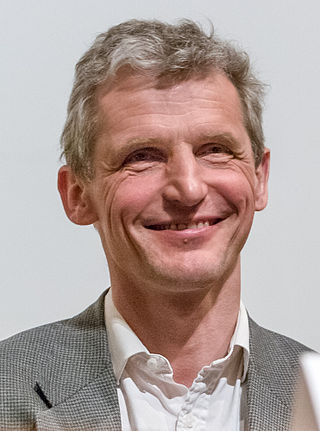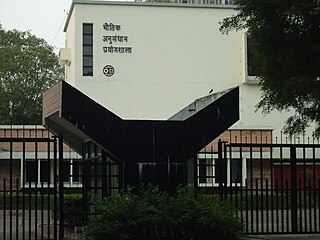
In condensed matter physics, a Bose–Einstein condensate (BEC) is a state of matter that is typically formed when a gas of bosons at very low densities is cooled to temperatures very close to absolute zero. Under such conditions, a large fraction of bosons occupy the lowest quantum state, at which microscopic quantum mechanical phenomena, particularly wavefunction interference, become apparent macroscopically.

Wolfgang Ketterle is a German physicist and professor of physics at the Massachusetts Institute of Technology (MIT). His research has focused on experiments that trap and cool atoms to temperatures close to absolute zero, and he led one of the first groups to realize Bose–Einstein condensation in these systems in 1995. For this achievement, as well as early fundamental studies of condensates, he was awarded the Nobel Prize in Physics in 2001, together with Eric Allin Cornell and Carl Wieman.
An atom laser is a coherent state of propagating atoms. They are created out of a Bose–Einstein condensate of atoms that are output coupled using various techniques. Much like an optical laser, an atom laser is a coherent beam that behaves like a wave. There has been some argument that the term "atom laser" is misleading. Indeed, "laser" stands for light amplification by stimulated emission of radiation which is not particularly related to the physical object called an atom laser, and perhaps describes more accurately the Bose–Einstein condensate (BEC). The terminology most widely used in the community today is to distinguish between the BEC, typically obtained by evaporation in a conservative trap, from the atom laser itself, which is a propagating atomic wave obtained by extraction from a previously realized BEC. Some ongoing experimental research tries to obtain directly an atom laser from a "hot" beam of atoms without making a trapped BEC first.

The Physical Research Laboratory is a National Research Institute for space and allied sciences, supported mainly by Department of Space, Government of India. This research laboratory has ongoing research programmes in astronomy and astrophysics, atmospheric sciences and aeronomy, planetary and geosciences, Earth sciences, Solar System studies and theoretical physics. It also manages the Udaipur Solar Observatory and Mount Abu InfraRed Observatory. The PRL is located in Ahmedabad.

The MIT Department of Physics has over 120 faculty members, is often cited as the largest physics department in the United States, and hosts top-ranked programs. It offers the SB, SM, PhD, and ScD degrees. Fourteen alumni of the department and nine current or former faculty members have won the Nobel Prize in Physics.
In condensed matter physics, an ultracold atom is an atom with a temperature near absolute zero. At such temperatures, an atom's quantum-mechanical properties become important.
David Edward Pritchard is a professor at the Massachusetts Institute of Technology (MIT), working on atomic physics and educational research.
Eric J. Chaisson is an American astrophysicist known for his research, teaching, and writing on the interdisciplinary science of cosmic evolution. He is a member of the Center for Astrophysics | Harvard & Smithsonian, teaches natural science at Harvard University and is an elected Fellow of the American Association for the Advancement of Science.
Academics at the Massachusetts Institute of Technology are organized into 6 divisions containing 32 academic departments or faculties along with many interdisciplinary, affiliated, and intercollegiate research and degree programs. The Schools of Engineering, Science, Sloan School of Management, Humanities, Arts, and Social Sciences, Architecture and Urban Planning, and the Whitaker College of Health Sciences and Technology.
The Institute of Space and Planetary Astrophysics, also known as by its abbreviation ISPA, is a premier and national research institute of the University of Karachi, engaging the theoretical and applied studies and research into topics pertaining to Astronomy, Astrophysics, Satellite Communication, Space Flight Dynamics, Atmospheric Science, Climatology, GIS & Remote Sensing and other related subjects. The institute has network of various mathematics and physics laboratories located in various universities of Pakistan, while it operates a single Karachi University Astrophysics Observatory.

Nergis Mavalvala is a Pakistani-American astrophysicist. She is the Curtis and Kathleen Marble Professor of Astrophysics at the Massachusetts Institute of Technology (MIT), where she is also the dean of the university's school of science. She was previously the Associate Head of the university's Department of Physics. Mavalvala is best known for her work on the detection of gravitational waves in the Laser Interferometer Gravitational-Wave Observatory (LIGO) project, and for the exploration and experimental demonstration of macroscopic quantum effects such as squeezing in optomechanics. She was awarded a MacArthur Fellowship in 2010.

Katharine Blodgett Gebbie was an American astrophysicist and civil servant. She was the founding Director of the Physical Measurement Laboratory of the National Institute of Standards and Technology (NIST), and of its two immediate predecessors, the Physics Laboratory and the Center for Atomic, Molecular and Optical Physics, both for which she was the only Director. During her 22 years of management of these institutions, four of its scientists were awarded the Nobel Prize in Physics. In 2015, the NIST Katharine Blodgett Gebbie Laboratory Building in Boulder, Colorado was named in her honor.

The Institute for Theoretical Atomic, Molecular and Optical Physics (ITAMP) is an international scientific learned society based at the Center for Astrophysics | Harvard & Smithsonian in Cambridge, Massachusetts. It was established in 1988 to alleviate a perceived shortage of theorists in atomic, molecular, and optical physics (AMO) at major universities throughout America. AMO concerns the study of matter-matter and light-matter interactions at the scale of one or a few atoms.

Julia K. Steinberger is Professor of Ecological Economics at the University of Lausanne. She studies the relationships between the use of resources and performance of societies. She is an author of the Intergovernmental Panel on Climate Change (IPCC) 6th Assessment Report, contributing to the report's discussion of climate change mitigation pathways.
The I. I. Rabi Prize in Atomic, Molecular, and Optical Physics is given by the American Physical Society to recognize outstanding work by mid-career researchers in the field of atomic, molecular, and optical physics. The award was endowed in 1989 in honor of the physicist I. I. Rabi and has been awarded biannually since 1991.
Tanya Zelevinsky is a professor of physics at Columbia University. Her research focuses on high-precision spectroscopy of cold molecules for fundamental physics measurements, including molecular lattice clocks, ultracold molecule photodissociation, as well as cooling and quantum state manipulation techniques for diatomic molecules with the goal of testing the Standard Model of particle physics. Zelevinsky graduated from MIT in 1999 and received her Ph.D. from Harvard University in 2004 with Gerald Gabrielse as her thesis advisor. Subsequently, she worked as a post-doctoral research associate at the Joint Institute for Laboratory Astrophysics (JILA) with Jun Ye on atomic lattice clocks. She joined Columbia University as an associate professor of physics in 2008. Professor Zelevinsky became a Fellow of the American Physical Society in 2018 and received the Francis M. Pipkin Award in 2019.

Dara J. Norman is an astronomer and the deputy director of the Community Science and Data Center at the National Science Foundation's National Optical-Infrared Astronomy Research Laboratory (NOIRLab) in Tucson, Arizona. She is also the Association of Universities for Research in Astronomy Diversity Advocate at NOAO. Her research centers on the influence of Active Galactic Nuclei (AGN) on the evolution of galaxies. In 2020, she was inducted into the inaugural cohort of American Astronomical Society Fellows in recognition of her leadership and achievements.
While STEM fields all over the world are dominated by men, the number of Pakistani women in 'STEM' is low due to one of the highest gender gaps in STEM fields. However, over the time, some Pakistani women have emerged as scientists in fields like Physics, Biology and computer sciences.
Paola Cappellaro is an Italian-American engineer who is a Professor of Nuclear Science and Engineering at the Massachusetts Institute of Technology. Her research considers electron-spin resonance, nuclear magnetic resonance and quantum information processing. She leads the MIT Quantum Engineering Group at the Center for Ultracold Atoms.

Gretchen K. Campbell is an American atomic, molecular, and optical physicist associated with the National Institute of Standards and Technology. She works in the field of atomtronics and has received awards in recognition of her research contributions on Bose-Einstein condensates.









